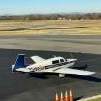-
Posts
229 -
Joined
-
Last visited
Jake@BevanAviation's Achievements
-

KFC150 autopilot roll clutch slips
Jake@BevanAviation replied to Smroot's topic in General Mooney Talk
@Smroot Looks like you have the KS17X series of servos. They are different from the more common KS27X series of servos. They do not have separate mount plats that the servo bolts to. The servo slip clutch and mount are all part of the servo assembly. They can be a bigger pain to remove from the aircraft due to it being a complete assembly. Also, parts are hard to get for theses servos. Make sure whoever is working on the servo knows how to service the units. Attached is the IM for reference. MOONEY M20J M20K INSTALL 006-00249-0000_13.pdf -

Mooney M20J LM with KFC 100 wants altitude hold
Jake@BevanAviation replied to Lawmansteve's topic in General Mooney Talk
@Lawmansteve The KAP100 was a roll axis only autopilot, the KAP150 was roll, pitch, and pitch trim. The KFC150 added flight director functions with roll, pitch, and pitch trim standard, with a option for yaw. Finding a good used KAP150 should not be that big of a problem, the challenge is the servos, brackets, hardware, ect. Not to mention the install cost and paperwork to make it all legal. If you are wanting a modern 2-3 axis autopilot system it might be smart to look at new systems. The Aerocruze will be the lowest cost but has some limitations. S-Tec and Garmin will be a step up from the Aerocruze. With the equipment you already have in the aircraft you can't go wrong with the GFC500. It will cost you more vs the Aerocruze but you will have a lot more features with Garmin. -
@Fly Boomer when using the up/down rocker switch you are putting in a hard pitch up/down command. The servo drive should start out slow and get slightly faster the longer you hold the up/down rocker. You will not see full speed due to the tach feedback that is sent back to the flight computer to govern the speed of the servo. The servo will continue to drive when using the up/down rocker switch until you tell it to stop, easiest way to stop the drive is to use the CWS switch or disconnect the system. The way I check auto trim functions is pull the yoke out to elevator neutral and engage the system. I apply pressure to the yoke by pushing or pulling on the yoke and wait 3-5 seconds to see if auto trim start to drive. Once it starts driving I remove the pressure and check to see if the trim servo stopped driving and then repeat the process in the opposite direction. Ideally this test should be done with the engine running and the attitude gyro spooled up unless you have glass indicators.
-
@Fly Boomer Everything sounds normal if you are not supporting the yoke, the weight of the elevator and gravity is enough force to close the micro switches in the pitch servo to tell the computer to start auto trim. Normally there is a 3-5 second delay before auto trim will start. Auto trim will continue to run until you remove the load on the pitch servo. The only thing that sticks out to me is that you cannot overpower the trim servo. All servo slip clutches should be set around 22 inlb. Preflight test procedure is in the AFMS under section 4a. I have attached a copy of the AFMS for reference. AFMS KFC150 M20J-K.pdf
-

M20K with KFC-200 Problems
Jake@BevanAviation replied to MooneyMuscle's topic in Modern Mooney Discussion
@anthonydesmet if the flight bars are always down when selecting alt hold and the aircraft follows, but works fine without alt hold selected. My guess is something has failed on the alt hold board inside the KC295 flight computer. Normally when this happens its a problem with the transducer assembly or the custom IC on that board. Unfortunately, both of those components are no longer available and must be sourced from known good working units. You could try disconnecting the static line to the computer and retest on the ground to see if there was any blockage in the line. However, I would not be surprised to hear that it works exactly the same on the ground when selecting alt hold. These failures are becoming more common as the systems continue to age. If you have a local avionics shop that has the flight line tester, there is a test point that will tell you what the output of the transducer is. Ideally, it should be around 0vdc. Applying pressure or vacuum to the transducer port will cause the voltage to change. When they fail, they normally get stuck at a certain voltage. Sometimes you can beat on the KC295 outer case a couple of times and they will start to act normal, but at some point the issue will come back. -

KFC 150 Autopilot misbehaving
Jake@BevanAviation replied to IvanP's topic in Modern Mooney Discussion
@Brad Reid If the system will engage with FD and ALT hold only and when selecting a lateral control mode like heading, nav, approach the system disconnects. I would check the compass valid input to the computer. If the compass valid fails and you have a lateral control mode selected it will instantly disconnect the system. It will not allow you to engage the system with a lateral control mode if the compass valid has failed. -

M20F autopilot, seeking advice
Jake@BevanAviation replied to PierreZee's topic in Avionics/Panel Discussion
Will need to replace the Aspen with a G5, GI275, or G3x system for the GFC500 autopilot. If you are wanting to keep the Aspen your choices drop down to Aerocruze 100, S-Tec 55x/3100. Also, is the navigator a GNS430W? You might have some limitations if the GPS navigator is not WAAS. -
GI-275 ADAHRS+AP units work just fine with the KAP and KFC 150 series autopilots. The KAP will not have flight bars and there is no alt preselect functions with a GI-275. You must follow the alignment procedure outlined in the GI-275 IM when interfacing with the King autopilot. We have done this interface multiple times on various airframes and no issues. Make sure whoever is the installing shop knows this interface, has the KTS158 or has built the breakout harness in the GI-275 IM before, and has done the alignment to the flight computer.
-

Century 2000 AP Annunciator Lights Out
Jake@BevanAviation replied to Lax291's topic in Avionics/Panel Discussion
Lamps are the T-1 mini series. They are soldered to one of the motherboard assemblies behind the bezel. You have to remove the front bezel and remove both motherboard assemblies to gain access to the lamps. Just don't break any pins off the sockets. -

Century 2000 Autopilot Computer Repair
Jake@BevanAviation replied to FLYFST's topic in Modern Mooney Discussion
@FLYFST With Century Flight Systems being out of business the support for Century autopilots systems is dropping off pretty fast unless someone has a supply of parts. The problem with the Century 21, 31, 41, and 2000 is there are not many used units and some of the parts I could only get from Century. For example, if it is an altitude hold issue with the Century 2000, I have no new transducer parts and no new board assemblies with the revised alt hold transducer. I have fixed some for other customers but I had to have a working parts unit. Some times you can get lucky and find a unit on eBay or a salvage yard. However, the C2000 is voltage specific and there were several revisions to the board assemblies. What issue are you having with your C2000 system? -
The Century 21 MM calls has the IC listed as a MC14016BCP (quad analog switch) or a Century PN of 48S114.
-
Originally the 1k 5% 1w load resistors are only used on the Century 4, 41, and 2000 systems. See note below. Service Bulletin 23096 has revised this note and added the Century 21. The latest version of the GI275 IM has this revision included. If you can measure the heading error voltage when the system stop responding, move the heading bug and see if you still see a voltage change. The heading bug error voltage should go above and below the reference voltage. Reference voltage should be around 4.8VDC (half of regulated DC supply 9.6). If the heading error will still change with input the problem is not with the GI275. With Century Flight Systems being out of business support for any legacy system is going to be very limited. As parts continue to diminish there will be even less support in the future. The Century 21, 31, and 41 used a gate IC that was used to route error signals on the motherboards. If the gate fails the signal stops at that component. They also used ribbon cables to interconnect the motherboard assemblies. The ribbon cables will delaminate over time and can cause issues as well.
-
Yes, you would want to use the bracket that is in your aircraft for servo mounting. Just be sure that the servo dash number matches the one you have. Some servos are voltage specific 14 or 28.
-
Possible issue in the KC191 flight computer or roll servo. If you can gain access to the roll servo and disconnect it from the ship you could monitor to drive command across pins D and L at the roll servo connector to the ship. With a DC volt meter the AI spooled/level, the heading/course pointer under the lubber line, and the autopilot engaged in heading and AP engage modes you should see close to 0vdc. Moving the heading bug left and right of the lubber line should create a increasing DC drive voltage. Going one direction will be positive voltage and the other direction would be negative voltage. This will check the drive voltage from the computer. If you check Pins E to C this is the solenoid engage voltage. It will go positive and stay positive when the flight computer is engaged. It would also be helpful if you could find out what servo version you have. Some Mooney's have the KS-17X series of servos, other have the more common KS-27X series. Both servo assemblies function exactly the same but the KS-17X have different parts and some a getting hard to find.
-

G500 - KFC200 integration settings
Jake@BevanAviation replied to milotron's topic in Avionics/Panel Discussion
The autopilot configuration page should be set for KI525 and at default values, the flight director page should be set for KI256 and at default values. The GAD43 gyro emulation type should be KI256. You need to align the flight computer to the GAD using the GAD output test. You should follow King installation bulletin 430 using the King flight line test set (KTS 150). If the KTS150 is not available you can fabricate a breakout harness. The GI275 IM shows how to make this harness if needed.










